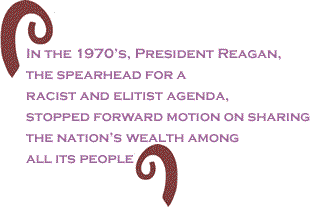
|
|||||||||||||||||||||
 |
|
Slaves got the animal parts that their masters thought
were unfit for whitefolks to eat. Pig intestines, it turned
out, became an African American delicacy: chitlin’s. They also got
the jobs unfit for white folks. Even after slavery ended, they have
gotten jobs only after whites have had the first pickin’s. Unfortunately,
there is no way of making something good out of underemployment.
Blacks fought for greater inclusion and advancement
in these industries as well as for better wages and benefits, as
evidenced by the militant organizing in Detroit’s auto sector and
their strong union participation. With these jobs, they could afford
to buy homes, send their kids to college, save for retirement, and
get their family health needs paid for through employer-paid insurance.
As a result, cities like Detroit and Los Angeles witnessed
the growth of middle class and even affluent Black neighborhoods.
Since George Bush became President in 2001, the country
has lost over 2.7 million well-paying manufacturing jobs, most in
core urban areas. But these are not short-term trends tied to partisan
politics. The decline of manufacturing as a share of the economy
has worsened for the last four decades. In 1965, the share of the
economy that was linked to manufacturing was 53 percent. By
1988, it was 39 percent, and by 2004 it had plummeted to 9 percent. While we used to make planes, steel
and cars, now we make burgers and fries, and we make beds. Laid
off auto workers, for the most part, will not find comparable jobs.
National averages show that 57 percent of laid off workers
make less in their next job and a third of those make a full 20
percent less, with substantially less benefits. The median
manufacturing wage is about $51,000 a year, plus benefits. Jobs
in the growing hospitality sector pay median wages of $16,000; in
health services, a median of $33,000. The decline of manufacturing
will only worsen the racial disparity in health care coverage. Over
28 percent of Blacks have no health insurance, compared to 33 percent
of Latinos and 11 percent of whites.
Attacks on the working class and on
people of color go hand in hand. Busting unions and then blaming
Blacks for growing white economic insecurity has worked like the
con man with his hand in your pocket yelling “thief!” and pointing
in the other direction. Workers of all races need to stop
falling for this con. |
|
| Home | contents menu |
Your comments are always welcome. Visit the Contact Us page to send e-Mail or Feedback or Click here to send e-Mail to [email protected] e-Mail re-print notice
If you send us an e-Mail message we may publish all or part of it, unless you tell us it is not for publication. You may also request that we withhold your name. Thank you very much for your readership. |
|
| March
9, 2006 Issue 174 |
||||||||||||||
|
||||||||||||||
| contents menu | ||||||||||||||
|
||||||||||||||
| Printer Friendly Version in Plain Text or PDF format. Download free Adobe Reader. | ||||||||||||||
 |
||||||||||||||
 |
||||||||||||||
 |
||||||||||||||
 |
||||||||||||||
| |
||||||||||||||
| |
||||||||||||||






























